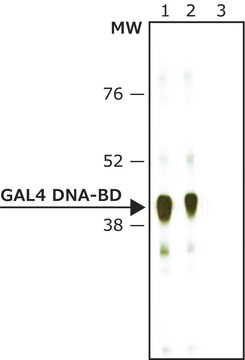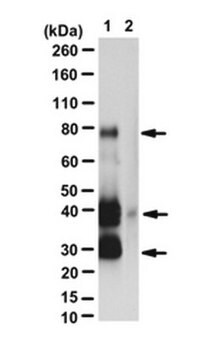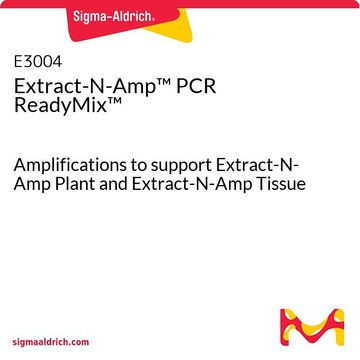G9293
Anti-GAL4, Activation domain antibody produced in rabbit
~1.0 mg/mL, affinity isolated antibody, buffered aqueous solution
Synonym(s):
Anti-Galactose 4
Sign Into View Organizational & Contract Pricing
All Photos(1)
About This Item
Recommended Products
biological source
rabbit
Quality Level
conjugate
unconjugated
antibody form
affinity isolated antibody
antibody product type
primary antibodies
clone
polyclonal
form
buffered aqueous solution
concentration
~1.0 mg/mL
technique(s)
western blot: 0.5 μg/mL using GAL4-AD fusion protein in Saccharomyces cerevisiae extract
shipped in
dry ice
storage temp.
−20°C
target post-translational modification
unmodified
General description
GAL4 protein is an 881 amino acid transcription factor containing an independent N-terminal DNA binding (147 amino acids) and C-terminal activator domains. It is a regulatory gene that belongs to GAL gene family. It is a component of yeast two hybrid system, where GAL 4 DNA-BD is fused to protein X (bait) and GAL4 activation domain is fused to protein Y (prey).
Useful in the study of protein:protein interaction studies. GAL4 DNA activation domain fusion proteins.
Immunogen
Synthetic peptide corresponding to amino acids of Saccharomyces cerevisiae GAL4 protein.
Application
Anti-GAL4, Activation domain antibody produced in rabbit has been used in western blotting.
Biochem/physiol Actions
GAL4 induces the genes that are responsible for regulation of galactose metabolism in saccharomyces cerevisiae. GAL4 protein is widely used for studying transcriptional activation in eukaryotes. The yeast two hybrid system is widely used to study to discover protein− protein interactions (PPIs) and protein−DNA interactions.
Physical form
The product is provided as a solution of affinity isolated antibody in 0.01 M phosphate buffered saline, pH 7.4, containing 1% bovine serum albumin and 15 mM sodium azide as a preservative.
Storage and Stability
For continuous use, store at 2-8 °C for up to one month. For extended storage, freeze in working aliquots. Repeated freezing and thawing is not recommended. Storage in “frost-free” freezers is not recommended. If slight turbidity occurs upon prolonged storage, clarify the solution by centrifugation before use. Working dilution samples should be discarded if not used within 12 hours.
Disclaimer
Unless otherwise stated in our catalog, our products are intended for research use only and are not to be used for any other purpose, which includes but is not limited to, unauthorized commercial uses, in vitro diagnostic uses, ex vivo or in vivo therapeutic uses or any type of consumption or application to humans or animals.
Not finding the right product?
Try our Product Selector Tool.
Storage Class Code
10 - Combustible liquids
WGK
WGK 3
Flash Point(F)
Not applicable
Flash Point(C)
Not applicable
Choose from one of the most recent versions:
Already Own This Product?
Find documentation for the products that you have recently purchased in the Document Library.
H Efsun Arda et al.
Molecular systems biology, 6, 367-367 (2010-05-13)
Gene regulatory networks (GRNs) provide insights into the mechanisms of differential gene expression at a systems level. GRNs that relate to metazoan development have been studied extensively. However, little is still known about the design principles, organization and functionality of
Guihong Tan et al.
Genetics, 183(1), 13-22 (2009-07-15)
Reversible and easy to use, temperature-sensitive (TS) mutations are powerful tools for studying gene function. However, TS alleles are rare and difficult to generate and identify, and this has limited their use in most multicellular organisms. We have generated and
Alessandro Berto et al.
EMBO reports, 19(5) (2018-04-11)
Cenp-F is a multifaceted protein implicated in cancer and developmental pathologies. The Cenp-F C-terminal region contains overlapping binding sites for numerous proteins that contribute to its functions throughout the cell cycle. Here, we focus on the nuclear pore protein Nup133
Our team of scientists has experience in all areas of research including Life Science, Material Science, Chemical Synthesis, Chromatography, Analytical and many others.
Contact Technical Service








